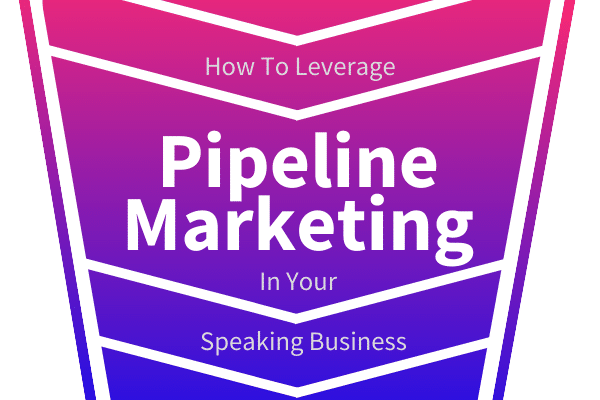Hey there and welcome to the SpeakerFlow Guide to pipeline marketing! In this guide, we’ll discuss the definition of pipeline marketing and Bizible, the company that originally created the term. We’ll also break down how to integrate pipeline marketing in each part of your speaking business, including your sales and marketing processes. This includes best practices for attracting inbound leads from search engines and social media in addition to standard sales and marketing tactics.
In short, by the end of this handbook, the goal is to have given you another of the tools to do what SpeakerFlow does best: ensure predictable revenue in your speaking business. Here, you will learn the value of pipeline marketing – for all B2B businesses – and how you can make it a reality. That way, you can rest easy that leads are able to find you and focus on what you’re really passionate about: speaking.
What is Pipeline Marketing?
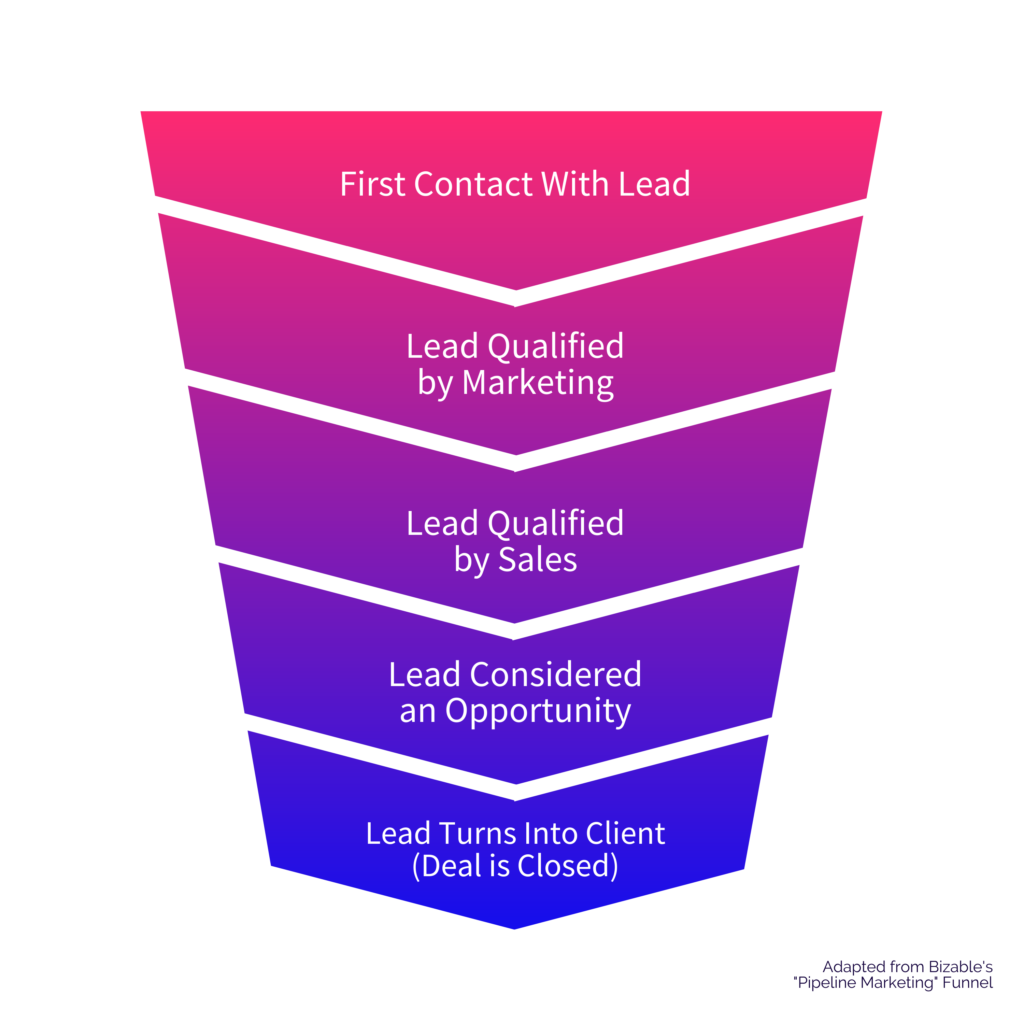
It probably comes as no surprise that, in many established businesses, sales and marketing teams still focus on the idea of quantity over quality. In other words, the goal is to get as many leads as possible as quickly as possible. It’s kind of like the idea that “All press is good press,” that any attention is good because it means brand exposure. Although this is partly true, more leads doesn’t necessarily mean more qualified leads.
For example, if we look at the speaking industry, this can be seen in companies that provide “lead lists” for upcoming events. Their main goal is to provide as many events for you to look into as possible. However, as you may know if you’ve purchased one of these lists, many of these events might not be applicable for you. Their budget might be too small, they might focus on an industry in which you don’t specialize – there are tons of factors that can take your list of 100 leads down to 5 that are actually worth pursuing. Frustrating, right?
In light of this persistent problem, marketing company Bizible coined the term “pipeline marketing” to put words to the idea of quantity as well as quality. In their words, “It’s about optimizing all aspects of marketing to widen the funnel at every stage and maximize marketing’s impact to growth.” To put it simply, pipeline marketing focuses on using a funnel like the one on the right. It takes into account sales and marketing touchpoints, such as nurturing tactics by sales people and interactions with your blog, for example. Ultimately, this means more qualified leads for your speaking business and more data (and thus, a better understanding) of what service each lead is best qualified to purchase.
What is Lead Attribution?
To implement the pipeline marketing approach to sales and marketing, you must first understand how sales and marketing interact with each other. Namely, you need to be able to answer, “How much revenue is generated from each marketing source?” These sources include paid ads on Google, organic traffic to your site, and referrals from affiliates. All in all, the lead count and value from these sources is described as “lead attribution,” and it is by tracking lead attribution that you can see which marketing efforts are generating the most leads and the most qualified leads. In other words, you can see which marketing efforts are and are not contributing to sales.
If you already have some form of lead attribution in your speaking business, bravo! You’re already ahead of the pipeline marketing game. On the other hand, if you don’t have lead attribution set up, no worries – that’s what this guide is for!
Single-Touch Lead Attribution
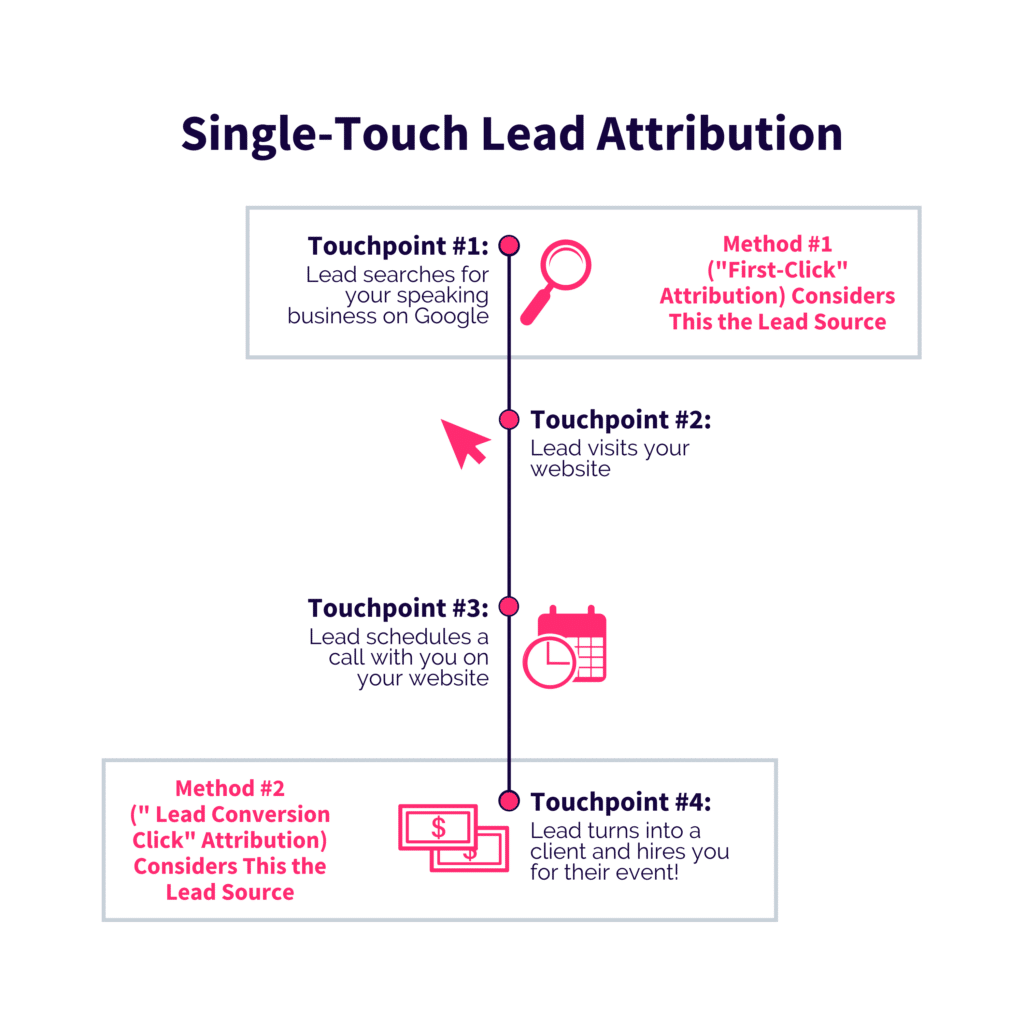
First and foremost, there are two primary models for lead attribution: the single-touch model and the multi-touch model. The single-touch model applies the value for the lead to either (a) the way that they first came in contact with your business or (b) the contact point that resulted in the sale. The first method is often described as “first click attribution” gives all of the credit to the action that first brought the lead to your website. The second method, the “lead conversion click attribution” method, gives the credit to the action that turned them from a lead into a client.
If we look at an example, if an event planner searches for you on Google, visits your site, schedules a call with you and ends up hiring you, the “first click” method would attribute the entire value of that sale to Google. The second method, on the other hand, would attribute it to the webpage for “Book a Call” (unless, of course, they were a personal referral).
With both of these single-touch models, the primary drawback is that neither considers the entire pipeline in the pipeline marketing process. Looking back at our funnel, the “first click” method focuses only on the top of the funnel while the “lead conversion click” method only looks at the bottom of it. In order to accurately track your leads, which are the most qualified, and where they are coming from, you need an attribution model that considers the entire funnel.
Multi-Touch Lead Attribution
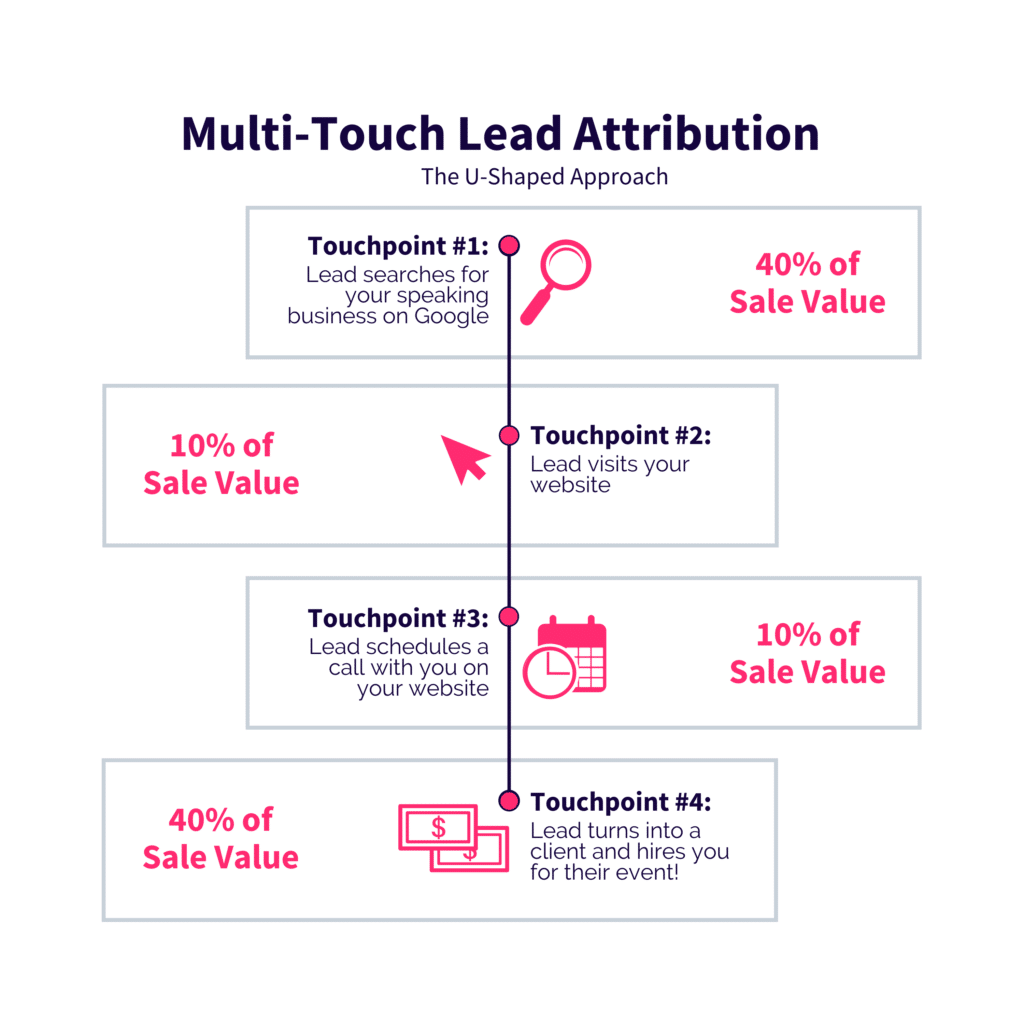
That brings us to the other option, when it comes to lead tracking, the multi-touch lead attribution model. Unlike the single-touch model, this model gives different weight to different touchpoints in the lead’s interaction with your business. In this way, you are distributing the credit for the sale across the many ways in which the lead came in contact with your business before they turned into a client. After all, it isn’t often that a person finds you, explores your site, and purchases your goods or services all in a single visit.
Because the divided value of the sale takes into account all of the parts of the funnel we looked at originally, multi-touch lead attribution is much more accurate than the single-touch models. However, it’s also harder to implement. This is especially true if you do not come from a sales or marketing background, as is the case for many speakers. As a result, many speaking businesses don’t accurately track their lead attribution and so don’t really know what part(s) of their business are working well.
That said, to get started with multi-touch lead attribution, there are two basic approaches you can take, regardless of your experience. The first is the “U-Shaped” model of multi-touch attribution approach. In this case, the first and last touchpoints in the process are given 40% of the credit for the sale. Then, the remaining 20% of the credit for the sale is equally attributed to each of the remaining touchpoints. Of the two multi-touch lead attribution models, this is the easier of the two to implement. Ultimately, it functions like a middle ground between the inaccuracy of the single-touch models and the complexity of custom multi-touch attribution models.
Choosing a Lead Attribution Model
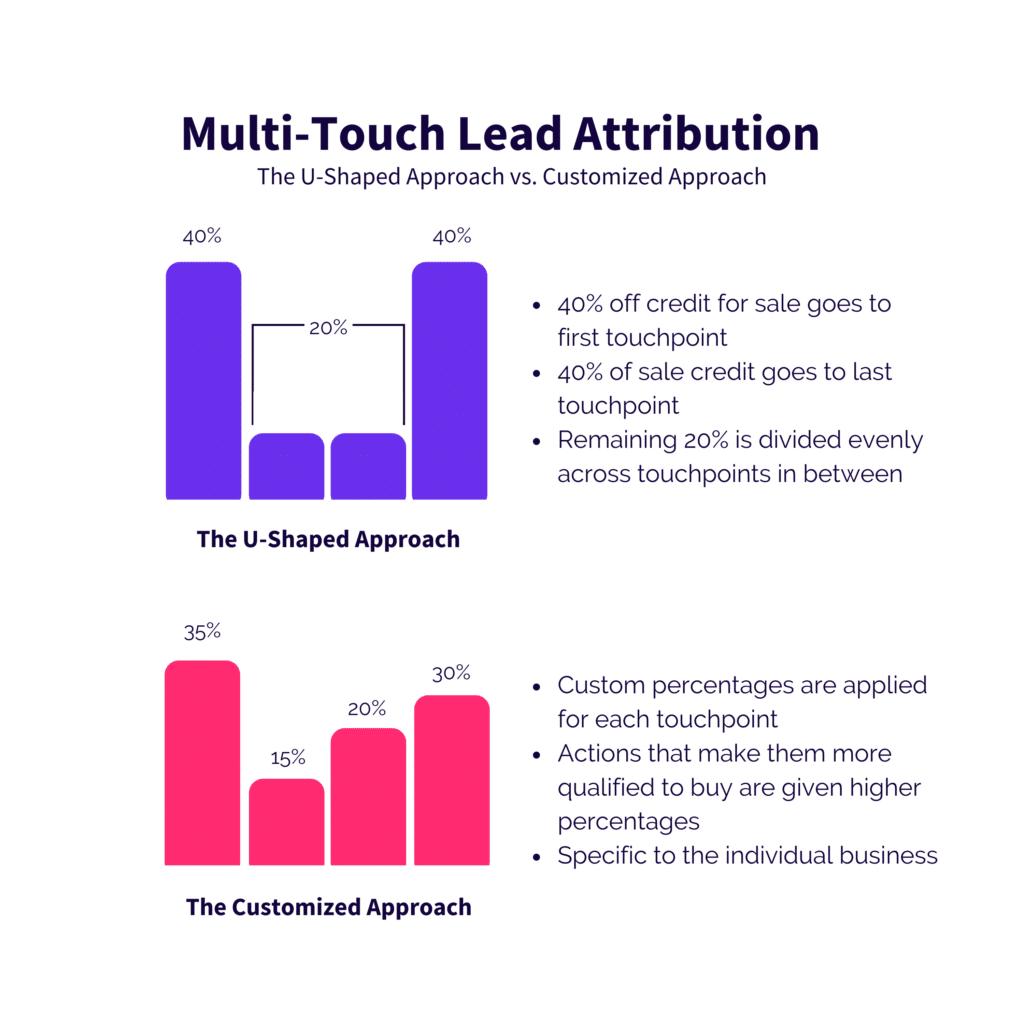
Considering each of these models, the most accurate and the most difficult to implement in your pipeline marketing strategy is a custom multi-touch method of lead attribution. Although this model is a little advanced, it also allows you to judge which leads are the most qualified based on custom percentages or scoring for your speaking business. For example, a visit to your website might earn a lead 5 points while scheduling a call with you might earn them 10 points. The more interested the lead suggests they are by their actions, the more points that action gets. Then, the more points a lead has, the more qualified they are to hire you! It’s all about using data to determine which leads are most worthy of your time, as you’re doubtless balancing a lot, between running your business and speaking.
Lead Generation Techniques
At this point, we’ve covered all of the basics of bringing proper lead attribution to your speaking business. Now, let’s dive into the next piece of the pipeline marketing puzzle: reeling in the leads.
With the rise of technology, many businesses have transitioned to lead generation entirely in the digital world. This includes speaking businesses and, as a result, there are a ton of digital tools you can use to make your business all the more visible on the web. In this section, we’ll break down four of the most impactful lead sources you should focus on this quarter.
Search Engine Optimization (SEO)
First of the many digital lead sources is an obvious one. I’m talking about search engines, especially Google. For many event planners and clients, a quick Google search is their go-to starting place for finding speakers. In light of this, the more you can set up your website and your process to work with Google’s algorithms, the more likely that event planner is to land on your site first and hire you. Enhancing your business in this way is referred to as search engine optimization, or SEO.
Website SEO
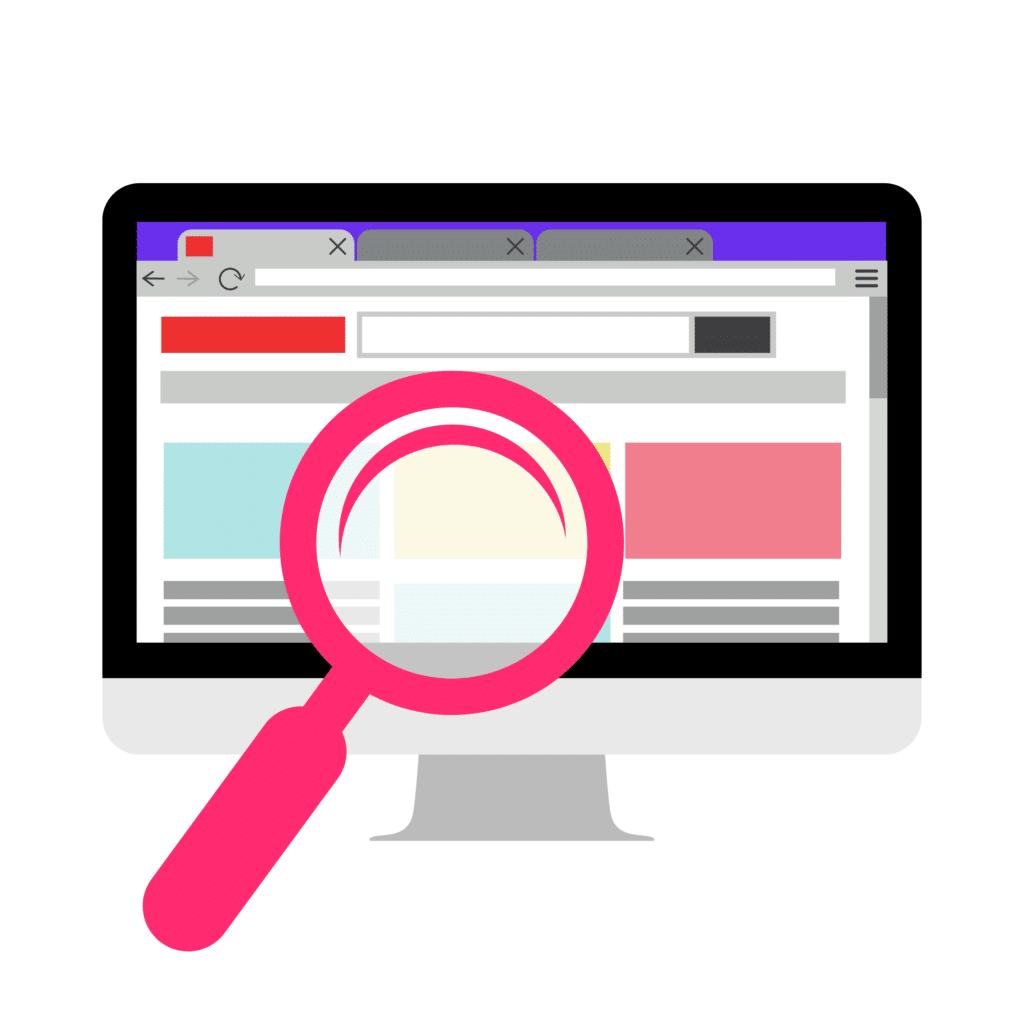
A few of the easiest ways to boost your SEO are to structure your webpages correctly, pinpoint your keywords, and showcase your credibility. The first of these, page structure, demands that your site use the proper text style. In other words, each page should have only one main header, designated as the “Header 1” style. From there, as the page goes on, the subheaders should increase so that each subheading under the primary header is “Header 2” and each subheading under that is “Header 3” (and so on, and so on). The idea is to create a ladder of the page’s information, like an outline for a paper, so that your page is easier to read at a glance.
The lowest rank on the text ladder, when you’re laying out your site, is the “Body” text. This text should take into account the second tactic to make your speaking business more visible: keywords. Unsurprisingly, these words and phrases are the key ideas that people are searching for on Google. These can include “keynote speaker,” “resiliency speaker,” or “change management speaker”. Be sure to identify which phrase(s) you want your website to rank for and include that phrase throughout your site’s headers (where it makes sense) and the body of the text.
Moving on, the third trick of the trade, when increasing your website’s visibility is showcasing your credibility. Besides your National Speakers Association or Canadian Association of Professional Speakers badge, you can also demonstrate trustworthiness by including a phone number, an email, a “Contact” page, and an “About Me” page. The primary goal is to show that you are easily reachable and happy to talk. That way, visitors to your site (and Google’s algorithm) know that you’re a real person and a legitimate business.
Mobile SEO
Above all, for good SEO, everything about your speaking business – including the layout of your website – needs to be available on mobile devices. Now more than ever, a growing percentage of businesses and potential clients work on the go. As a speaker, you know this more than most. So, the more optimized your speaking business is for mobile devices, the more accessible and modern-minded your leads will see you to be. Plain and simple.
Paid Advertising
Aside from leads finding your site organically, they can also find you through paid advertising. Unlike SEO, paid advertising directly targets people based on their search query or where they are searching. For example, if you search Google for “change management speaker,” there are several speakers’ names who appear at the top of the list. Each name and website has a green “Ad” button to the left of it. In this instance, each speaker with an ad is paying a set amount to appear for that keyword and for each time someone clicks on their link as a result of the ad. This is an example of pay-per-click (PPC) advertising. However, there are several other payment structures to choose from including display ads and pay-per-impression (PPI) ads.
Ultimately, the cost and payment structure vary depending on the platform in which you are running your ad. Besides search engines, paid advertising is also available on social media platforms, like Facebook and LinkedIn, as well as content platforms, like YouTube. Depending on your ideal client and your target industry, one platform may be a better lead source for your speaking business than others. Knowing this, it’s always wise to start small, test different platforms and ads, and adjust as you go.
Social Media
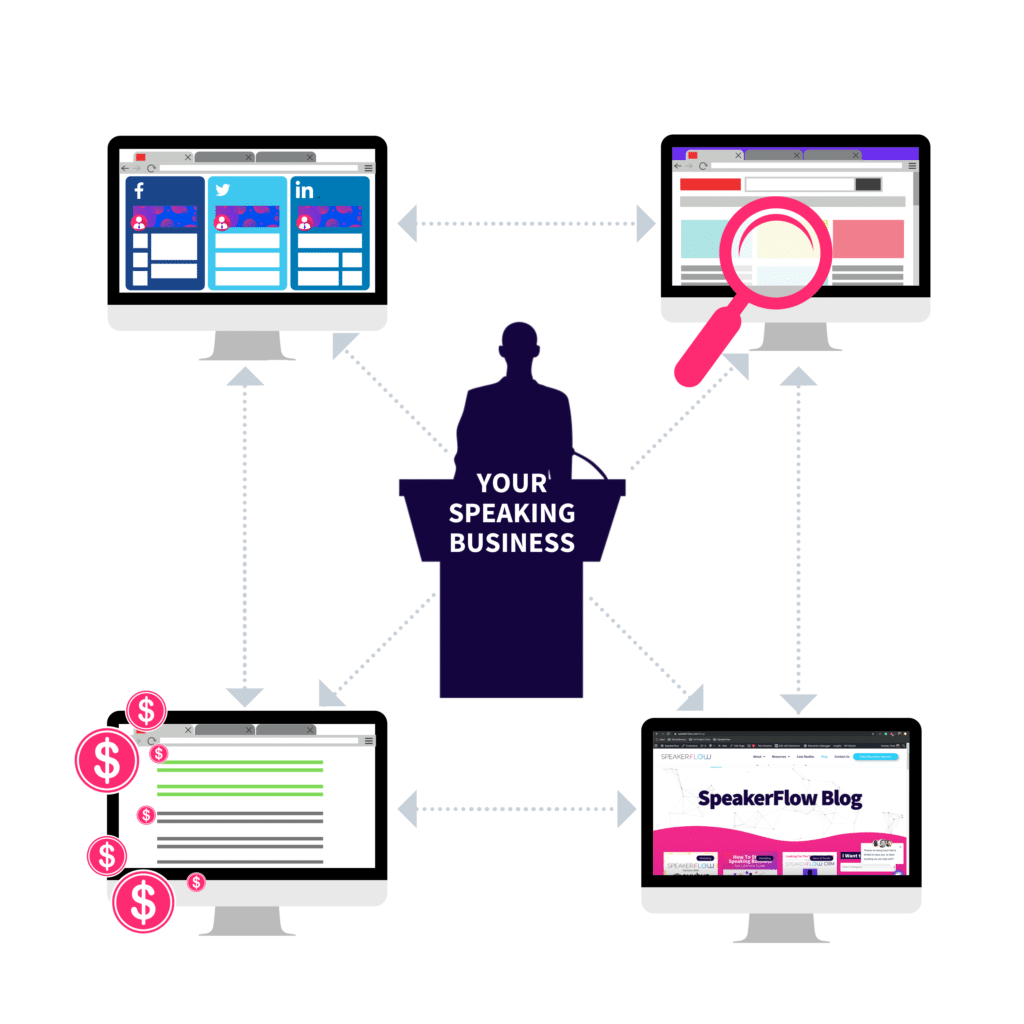
That said, although you can run ads on social platforms, maintaining a social presence can produce leads for a number of reasons that are completely free to you. For one thing, being social is a simple way to show people you’re a human being! Everyone loves self-confidence and skill and social media is a great way to showcase both. Additionally, you can’t go wrong with showing your personality. Some of the biggest and brightest scientists, athletes, celebrities, and speakers are remembered not only for their accomplishments but also for being themselves. What better way to inspire people and grab their attention than showing them you’re not afraid to meet the world head on?
Content Creation
Finally, the last lead generation source is content. Just as we discussed regarding SEO, content relies on knowledge of structure and the keywords you want to rank for. The most common form of content is blogs. If you’ve never written one before, blogs are great in their simplicity and their durability. In other words, while they don’t attract immediate attention, content creation and SEO can have a longer lasting impact for your speaking business. At SpeakerFlow, for example, our blogs weren’t originally our primary source of leads but, as we’ve grown, they’ve attracted more and more attention. This is simply because we made sure they had high-quality information and keywords, and they actually sound like us. Plus, as you write blogs, do what we did and share them on social media, to bring even more people to your site. Let the positive feedback loop of leads begin!
Traditional Sales Techniques
Besides bringing leads to your website, there are several techniques to get leads’ attention if they happened to slip through the cracks. This happens when, if we look back at the funnel, a lead falls off the radar before making it to the “Lead Considered an Opportunity” stage. In many cases, leads fail to convert simply because you haven’t crossed their path enough to garner their attention or because they’re not quite ready to buy. This is where retargeting and nurturing come into the pipeline marketing process.
Retargeting
Retargeting starts at the very top of the funnel and continues as the lead moves through each stage in the pipeline. Basically, retargeting analyzes where a lead has been and displays a specific ad based on what they looked at previously. For example, if a lead visited your website and clicked on your “Contact” page but didn’t book a call, you might use an ad that says, “Was it something I said?” The whole idea is to (a) get your business and your brand back in front of them and (b) get them to go back to your site and look around more. That way, they’ll see even greater proof of your skills and know they should hire you.
Another benefit to running retargeting campaigns is that they provide additional data for where the given lead is in your pipeline or funnel. Bizible describes these lead locations as “top of the funnel” (TOFU), “middle of the funnel” (MOFU), and “bottom of the funnel” (BOFU). Below is a quick summary of which parts of your website align with each part of the funnel:
- Top of the funnel (TOFU): Leads that visit your blog, podcast, or other content-related pages
- Middle of the funnel (MOFU): Leads that visit your “Services” or “Keynote Speaking” pages
- Bottom of the funnel (BOFU): Leads that visit your “Testimonials” or “Book a Free Discovery Call” pages
Like the lead scoring and custom lead attribution concepts described earlier, each of these parts of the funnel, respectively, show a lead moving through the sales and marketing process. In doing so, the lead in question becomes more and more qualified (and likely to turn into a sale).
Nurturing
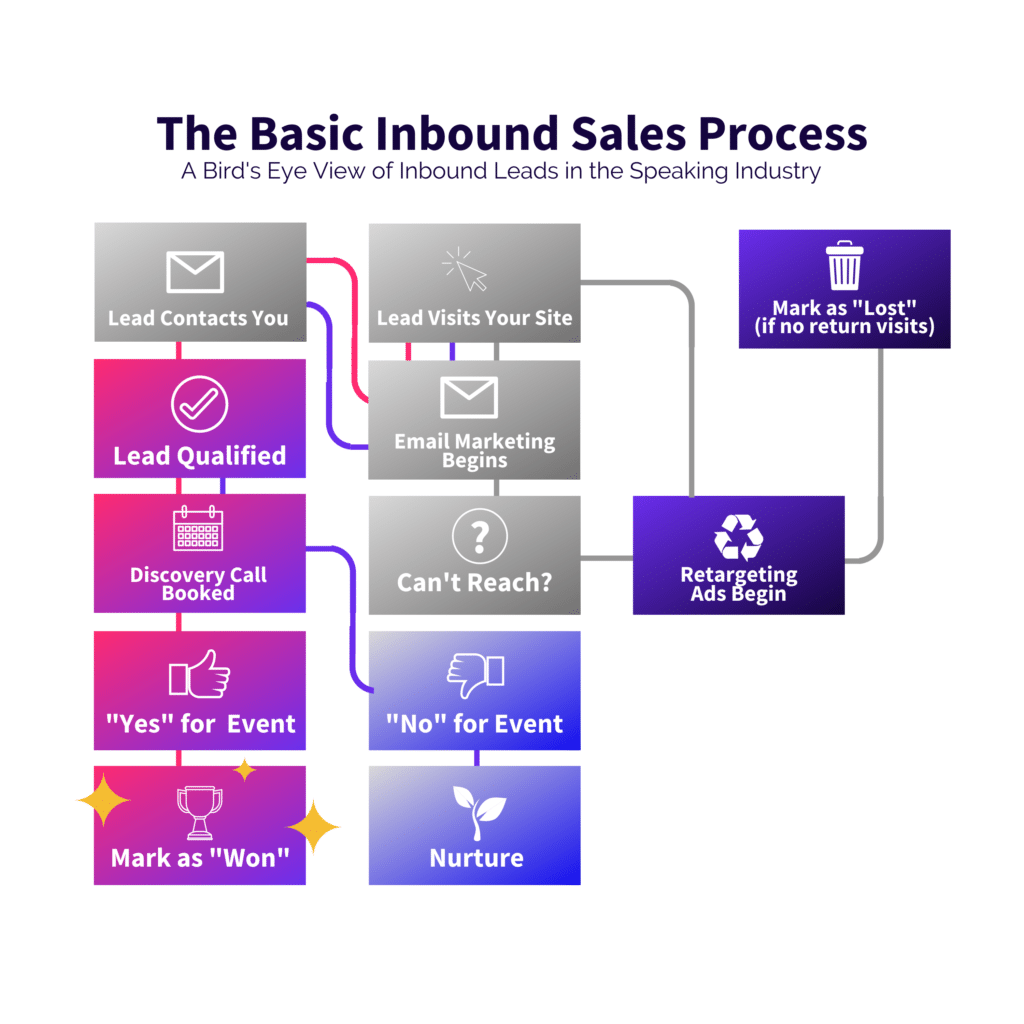
Another option to regain a lead’s attention is nurturing. Standard sales processes, like the one on the right, encourage a lead through the pipeline until they turn into a sale. This itself is a form of nurturing. However, the key place to ensure you nurture leads is when they express interest but, for whatever reason, have to wait before purchasing.
In the speaking industry, this happens all the time when event planners organize for multiple events at once. For example, let’s say that you reached out to an event planner about speaking for their annual conference this year. After visiting your site and an email or two, they sent you an email to say, “We went with another speaker for this year’s conference, but I think you’d be a good fit for next year”. Here, in order to be sure this lead doesn’t go to waste, lead nurturing is imperative.
A few easy ways to get in the habit of nurturing leads are by implementing a customer relationship management system (CRM), if you haven’t already, or a project management or reminder system. Both of these options, especially CRMs, are designed to help keep you on track, so you can minimize lead lost and effortlessly management inbound and outbound sales.
Data & Reporting
But, above all, how do you know if you’ve successfully leveraged pipeline marketing in your speaking business? The key to success is in proper analytics. In simple terms, your analytics and reporting tools and techniques should provide answers to the following questions:
- How many leads am I getting?
- Where are my leads coming from?
- What is my most profitable lead source?
- Where am I losing leads?
By establishing proper lead attribution at the beginning, this step in the pipeline marketing process, the last step, is a breeze. As Bizible describes it, “You have the data now that you’re doing pipeline marketing, so use it…Good reporting not only helps you, but makes sure other teams are on the same page with you as well.”
Every speaking business starts as a single solopreneur managing every part of the pipeline on their own. But, if you track sufficient data and manage your leads well, before you know it, you’ll have a whole team at your disposal, all paid for by your hyper-efficient sales and marketing processes. Sounds like the dream, right?
Conclusion
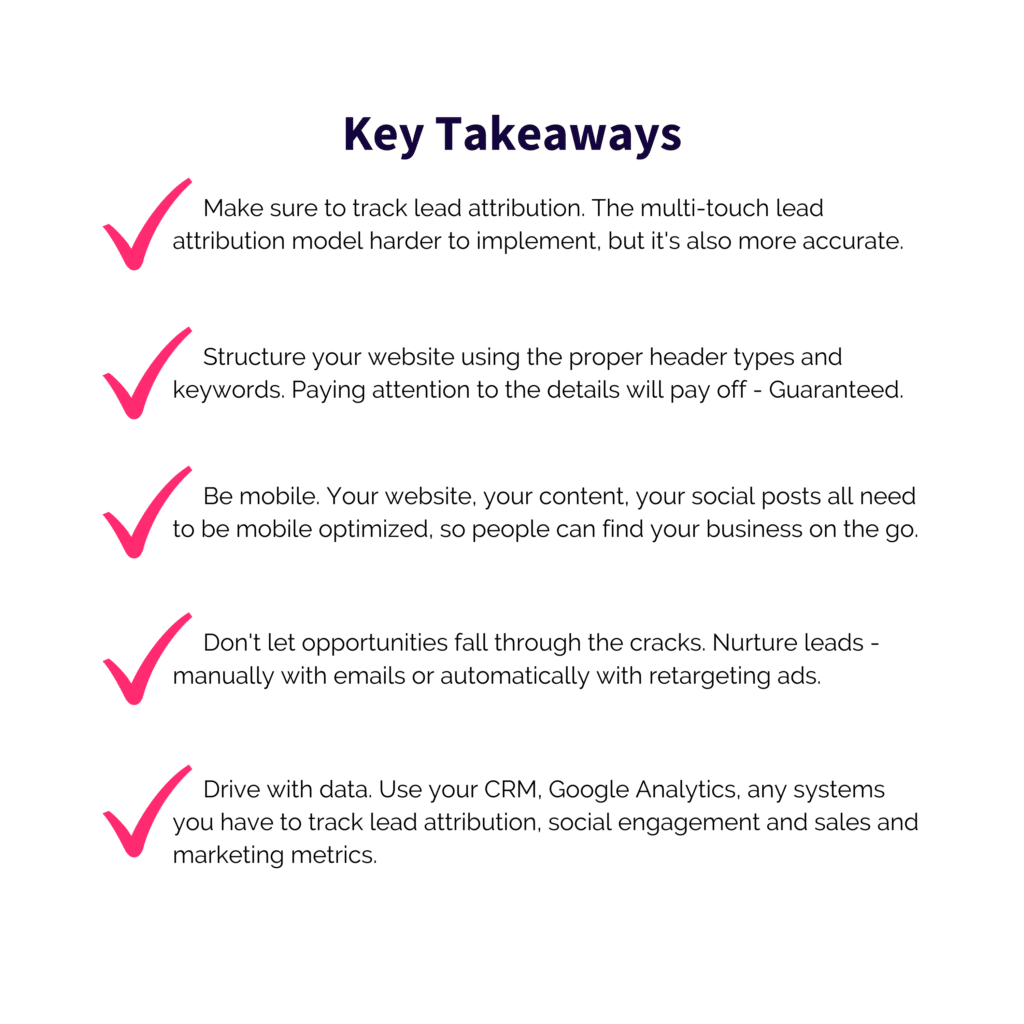
Ultimately, implementing pipeline marketing in your speaking business is all about understanding how your spend is related to your return. By understanding the connections between your sales and marketing efforts and how to improve them, you ensure consistent lead flow and a greater shot at predictable revenue for your speaking business.
You also ensure that you are focusing on the quality of your leads as well as the quantity. In other words, you make sure that you are spending your time and energy on the right leads at the right time. No business owner – let alone small business owners – have spare time to waste. That includes speakers, and, by optimizing the effort and money spent to bring leads to your website and your business, the number of hours you save is countless (not to mention the sheer amount of money).
Hopefully, this guide has given you the confidence to further implement pipeline marketing in your speaking business and start on the path to data-driven decisions. For more tips to take your speaking business to the next level, check out our “Resources” page or shoot us an email. We’re always here to help you level up. 😊


